- Welcome to LEC Forum.
Recent posts
#61
Numa Logic Programmable Controllers / Numa Logic Programmable [Logic...
Last post by Dave Loucks - August 27, 2014, 11:02:08 AMIf you haven't seen this link already, wanted everyone to know that I've scanned several of the old paper manuals, technical documents and even some of my application notes and programs and put them at http://pps2.com/communications/799.php.
The information includes:
This product family was discontinued back in the days before PDF's (some of this information dates back to the late 1970's). If anyone knows about manuals or technical documentation that you'd like to share, let me know and I'll get it posted.
The information includes:
- Numa Logic Communication Overview
Includes information on 6-byte protocol, Westnet II Data Highway RS-232 Asynchronous protocol, HPPC asynchronous advanced program loader (APL) protocol, PC1100/1200 Local Area Network protocol, PC500/502/503 and PC2000 (Siemens S5-100 and S5-115 PLCs, respectively rebranded to Westinghouse), as well as program loader port protocols. All this information is stored in two documents:
Numa-Logic Communication Overview (3.2 MB, 81 pages, scanned)
Numa-Logic Communication Appendix (2 MB, 69 pages, scanned) - NCMZ-1799 manual (also good for NCMZ-799)
- Numa-Logic PC100 / PC110 Programmable Controllers Operations and Programming Manual
- PC100 and PC110 Installation, Operation and Programming Manual
- NCMZ-798 hardware manual (preliminary 888 kB, 19 pages, scanned)
- NCMZ-798 BASIC Interpreter Optional Firmware (preliminary 661 kB, 40 pages, scanned)
- NCMZ-798 1100 LAN Optional Firmware (preliminary 1.3 MB, 44 pages, scanned)
- NCMZ-798-11 Alarm Text Optional Firmware (preliminary 310 kB, 18 pages, scanned)
- NCMZ-798-61 Radial Comm Optional Firmware (preliminary 466 kB, 16 pages, scanned)
- NCMZ-798-91 Modbus Slave Optional Firmware (preliminary 356 kB, 11 pages, scanned)
- Numa-Logic NL-300 (NL 3xx) Hardwired Card Logic Instructions, Wiring and Operations Manual
- Numa-Logic PC700 / PC900 / PC1100 Advanced Program Loader Manual
- Numa-Logic PC700/900/1100/1200/1250 Program Loader Manual (preliminary 19.9 MB, 84 pages, scanned)
- Numa-Logic PC1100 / PC1200 / PC1250 Programmable Controllers
- Programming Software for Numa-Logic PC 700, 900, 1100, 1200 and 1250 Programmable Controllers
- NLSW-784 Programming Software
- Numa-Logic HPPC 1500 / HPPC1700 / (a.k.a. the "Hippo")
This product family was discontinued back in the days before PDF's (some of this information dates back to the late 1970's). If anyone knows about manuals or technical documentation that you'd like to share, let me know and I'll get it posted.
#62
COMTRADE / COMTRADE parsing VBA (Excel) c...
Last post by Dave Loucks - June 05, 2014, 10:29:08 AMNew Features (V0.16h alpha) (31-OCT-17 (latest version)
Download this latest version at: https://pps2.com/cei/cei_16h.xlsb
Note: This Excel file contains macros and Windows will block execution of those macros by default. View this Microsoft article on how to unblock this feature so you can run the spreadsheet.
You will also be prompted to "update links" when first opening. Click Don't Update
Next click on the Graphing tab to view an example COMTRADE file that was imported. Click the Zoom+ or Zoom- to zoom the waveform. Press < Shift or Shift > to pan through the waveform.
New Features (V0.16g alpha) (22-MAY-17 (latest version)
Download this latest version at: http://loucks.ws/v/ct/cei_16g.xlsb
Or as always you can check and download the latest from within the program:
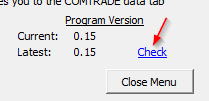
New Features (V0.16d alpha) (22-FEB-17)
Known bugs:
Here's a video tutorial on how to use this math functionality.
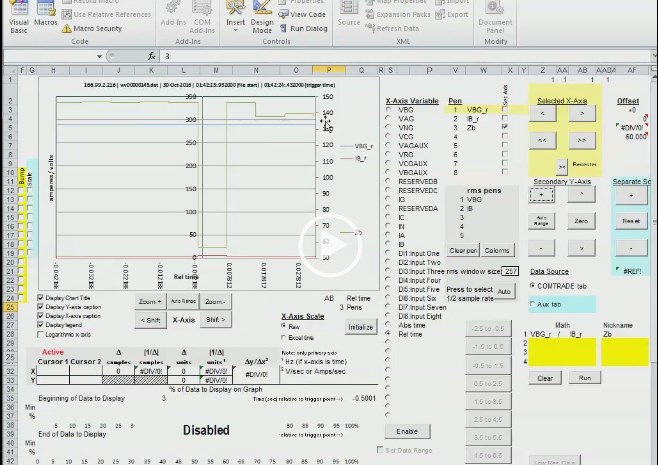
Download this latest version at: http://loucks.ws/v/ct/cei_16d.xlsb
Or as always you can check and download the latest from within the program:

New Features (V0.15d alpha) (3-FEB-17)
Here's a video tutorial on how to use the rms functionality.
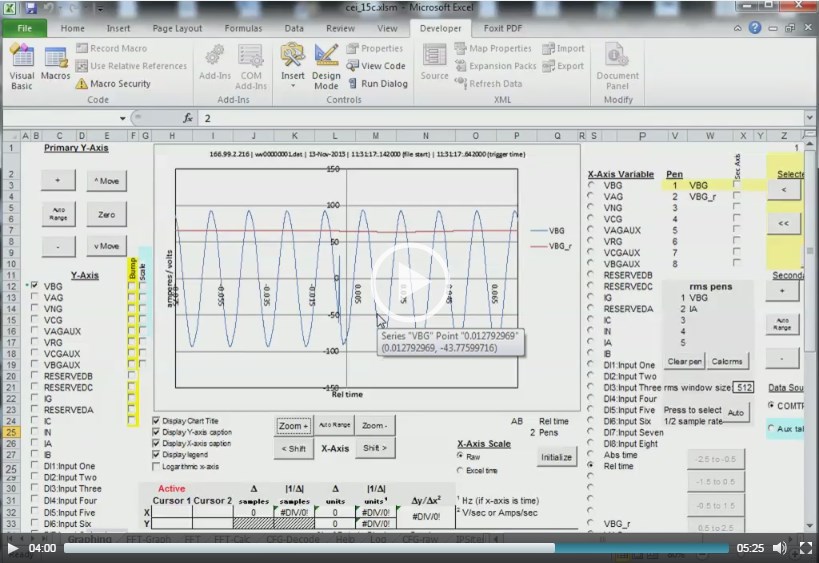
Download this latest version at: http://loucks.ws/v/ct/cei_15d.xlsb
New Features (V0.15 alpha)
Download this latest version at: http://loucks.ws/v/ct/cei_15.xlsb
New Features (V0.14n alpha)
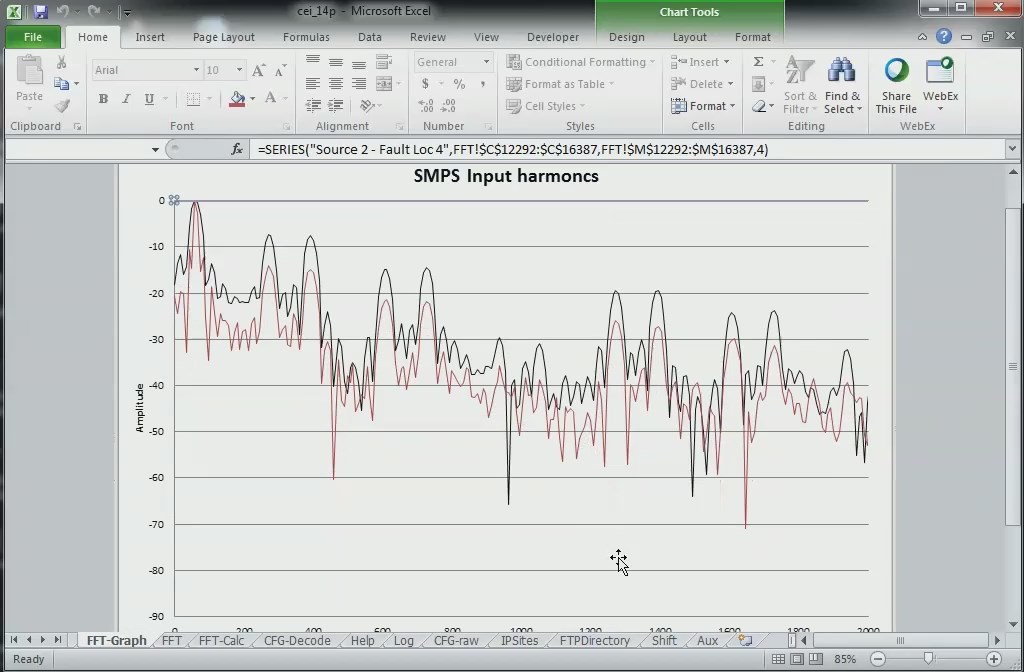
Download this latest version at: http://loucks.ws/v/ct/cei_14n.xlsb
Watch a video screencast video on how to use these FFT features:
https://pps2.com/v/s/1/ceifft.php
Did you have trouble getting the FFT function to run inside Excel? You might have either not installed the Analysis Toolpak, or you might not have enabled the functionality within Excel. Check out this video for an explanation:
https://pps2.com/v/s/1/atp.php
New Features (V0.14g alpha)
Download this latest version at: http://loucks.ws/v/ct/cei14g.xlsb
New Features (V0.13n alpha)
The new PX meter firmware captures 18 seconds (2.5 seconds pre-trigger and 15.5 post-trigger).
Download this latest version at: http://loucks.ws/v/ct/cei13n.xlsb
Here's the screencast explaining how to use the new features:
http://pps2.com/v/1/v013n.php
Features (V0.13k alpha)
Download this latest version at: http://loucks.ws/v/ct/cei13k.xlsb
Previous Version (V0.13a alpha)
(bug fixed that caused "Single" button download to fail)
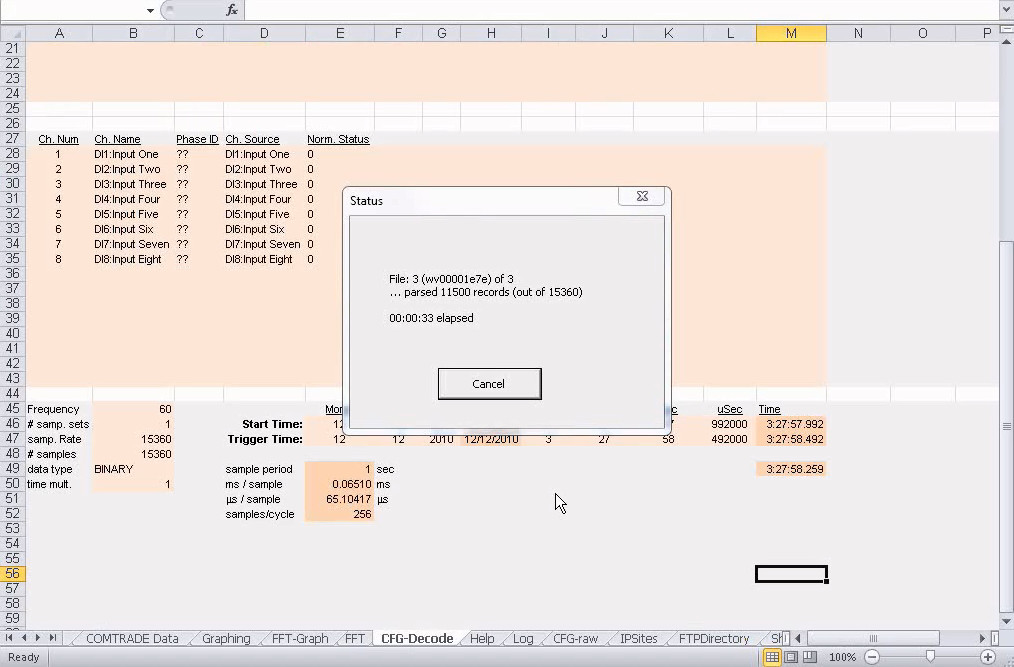
Also, since this program was written without requiring add-ins (which require admin rights to install), I can only use VBA to parse the files. Large files can require minutes to process. Likely a future version will include an add-in (compiled parsing code) to speed through the import for those users who have admin rights on their computer.
Here's the screencast that explains how to use these latest features:
http://pps2.com/v/1/v13.php
Download this latest version at: http://loucks.ws/v/ct/cei13a.xlsb
Previous Version (V0.12) Features
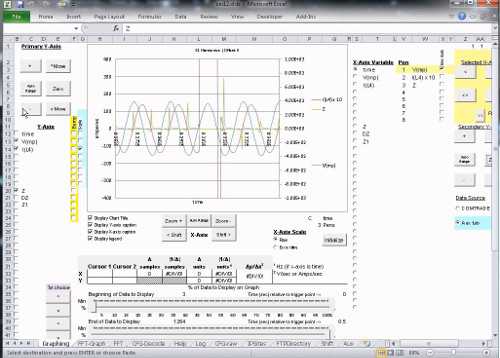
Here's the screencast that explains how to use these latest features:
http://pps2.com/v/1/v12.php
Download this latest version at: http://loucks.ws/v/ct/cei12a.xlsb
(Note: fixed bug in the 0.12a version that caused very slow operation in previous versions.)
Previous Version (V0.11) Features
Here's the screencast that explains how to use these latest features:
http://pps2.com/v/1/cei011.php
Download previous version V0.11 at: http://loucks.ws/v/ct/cei11.xlsb
Previous Version (V0.1) Features
Watch the screencast that explains the features added for this version: http://pps2.com/v/1/cei01_00.php
Download the previous version V0.1 at: http://loucks.ws/v/ct/cei10.xlsm
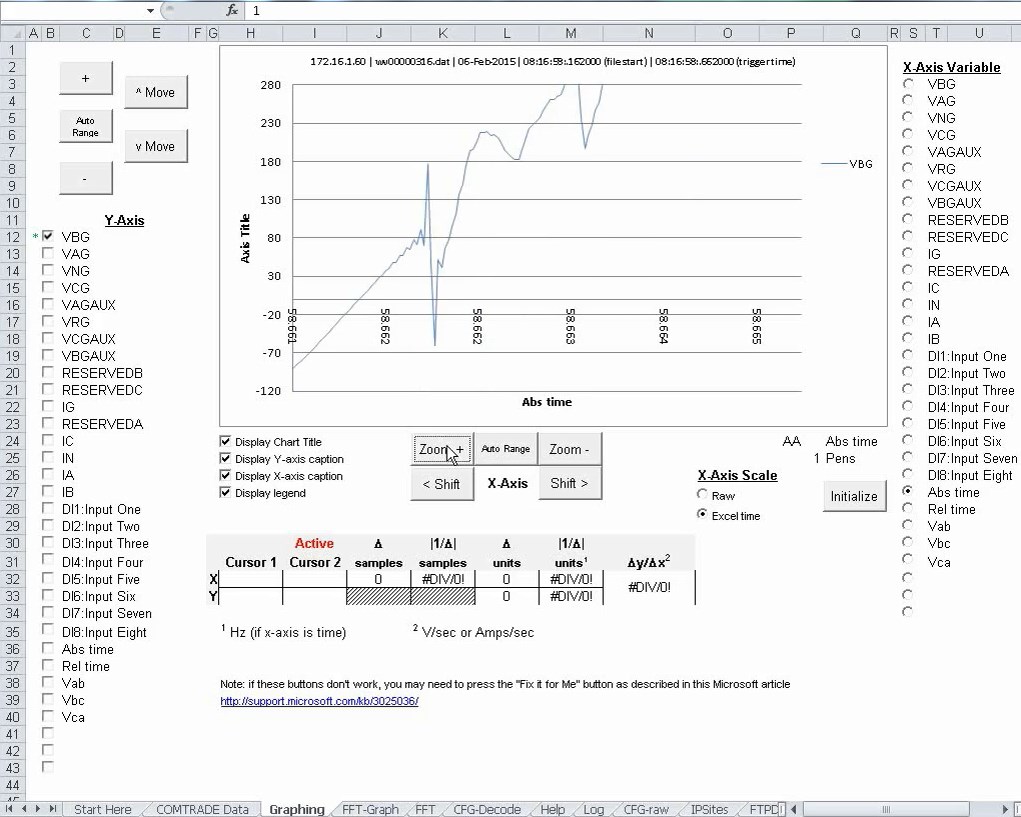
If you are interested in the VBA code that performs these functions I demonstrate how to use VBA to:
V 0.09 version is now available:
loucks.ws/v/ct/cei9_04.xlsm... or just click the check version link inside the earlier version to download the new version for free.
Flash version of screencast tutorial on how to use (I'll re-record this version's screencast in friendlier media format eventually!): http://loucks.ws/v/ct/update.html
Sample COMTRADE files to test out system:
https://app.box.com/s/yyi3ws6pk16ryhrhziw5uyny2d9y66af

Changes:
Waveform capture files from power meters, circuit breakers, reclosers and other IEDs (Intelligent Electronic Devices, in the utility vernacular) can provide valuable diagnostic information. Use this application to open a waveform file stored in the IEEE COMTRADE format and load the data found into an Excel spreadsheet. From Excel it is then a simple matter to create graphs, charts and other reports of the COMTRADE data.
I created a screencast that shows how to use it: loucks.ws/v/ct
You can download the Excel spreadsheet here: loucks.ws/v/ct/cei7b.xlsm
The VBA code is opened by clicking on Developer, then Visual Basic:

Once open, navigate through the VBA IDE to review my code.

- various bug clean up and stability improvements
Download this latest version at: https://pps2.com/cei/cei_16h.xlsb
Note: This Excel file contains macros and Windows will block execution of those macros by default. View this Microsoft article on how to unblock this feature so you can run the spreadsheet.
You will also be prompted to "update links" when first opening. Click Don't Update
Next click on the Graphing tab to view an example COMTRADE file that was imported. Click the Zoom+ or Zoom- to zoom the waveform. Press < Shift or Shift > to pan through the waveform.
New Features (V0.16g alpha) (22-MAY-17 (latest version)
- various bug clean up and stability improvements
Download this latest version at: http://loucks.ws/v/ct/cei_16g.xlsb
Or as always you can check and download the latest from within the program:

New Features (V0.16d alpha) (22-FEB-17)
- ability to perform math on data
You can select up to 4 "math pens" that are computed values based on +, -, *, / between any other data (including previously calculated values, so the equations can chain to build more complex y=(mx+b)/c kind of equations
Known bugs:
- Performing math on large data blocks
When doing math on multiple chained files, the calculated values are only visible when zoomed in to the high resolution data. When zoomed out, no math trends are shown for long multiple-file captures.
Here's a video tutorial on how to use this math functionality.

Download this latest version at: http://loucks.ws/v/ct/cei_16d.xlsb
Or as always you can check and download the latest from within the program:

New Features (V0.15d alpha) (3-FEB-17)
- rms calculation
You can now select from 1 to 5 trends from the COMTRADE file over which you can compute an rms calculation and plot as an overlay to the regular waveform data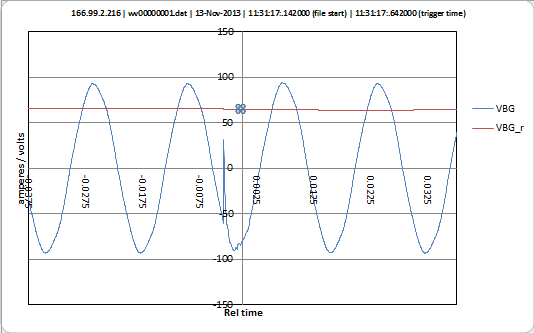
- Ability to display Fourier plots
Using the 'aux' data tab, you can now drop in data where rather than having the x-axis be a time value, the x-axis can be frequency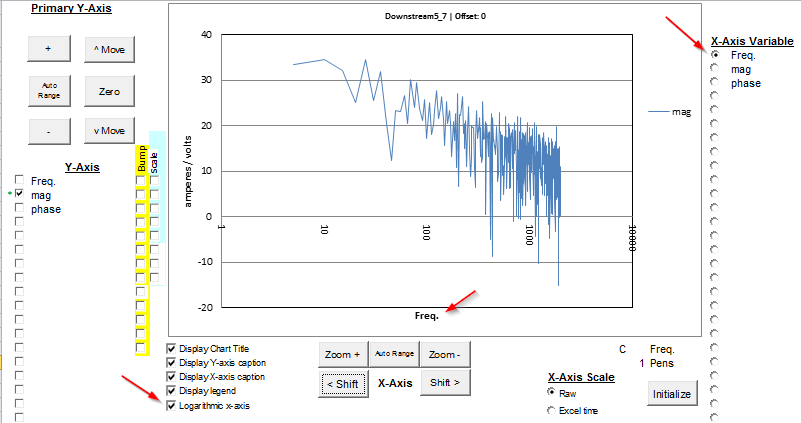
- Logarithmic x-axis
Added to support the ability to display Fourier series data
Here's a video tutorial on how to use the rms functionality.

Download this latest version at: http://loucks.ws/v/ct/cei_15d.xlsb
New Features (V0.15 alpha)
- Proxy server support
Now includes ability to connect to meter via FTP routed through a proxy server. Just check the checkbox and enter your proxy server address, colon, then port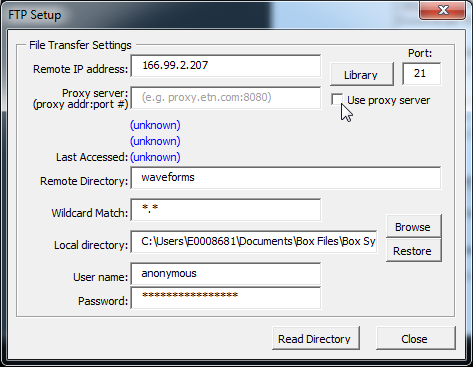
- FTP download bug fixes
- FFT graphing bug fixes
Download this latest version at: http://loucks.ws/v/ct/cei_15.xlsb
New Features (V0.14n alpha)
- New FFT features

Download this latest version at: http://loucks.ws/v/ct/cei_14n.xlsb
Watch a video screencast video on how to use these FFT features:
https://pps2.com/v/s/1/ceifft.php
Did you have trouble getting the FFT function to run inside Excel? You might have either not installed the Analysis Toolpak, or you might not have enabled the functionality within Excel. Check out this video for an explanation:
https://pps2.com/v/s/1/atp.php
New Features (V0.14g alpha)
- Fixed compatibility issues
Download this latest version at: http://loucks.ws/v/ct/cei14g.xlsb
New Features (V0.13n alpha)
- Pan and Zoom operate much faster (~10x)
- FFT features re-enabled (when I began the process of speeding up the code, I broke the FFT functionality. Now fixed.)
- Lissajous pattern plotting re-enabled (it too was broken when I wrote the faster code. Now fixed.)
The new PX meter firmware captures 18 seconds (2.5 seconds pre-trigger and 15.5 post-trigger).
Download this latest version at: http://loucks.ws/v/ct/cei13n.xlsb
Here's the screencast explaining how to use the new features:
http://pps2.com/v/1/v013n.php
Features (V0.13k alpha)
- COMTRADE import works 15x faster
Download this latest version at: http://loucks.ws/v/ct/cei13k.xlsb
Previous Version (V0.13a alpha)
(bug fixed that caused "Single" button download to fail)

- Able to import and append multiple sequential COMTRADE files
Also, since this program was written without requiring add-ins (which require admin rights to install), I can only use VBA to parse the files. Large files can require minutes to process. Likely a future version will include an add-in (compiled parsing code) to speed through the import for those users who have admin rights on their computer.
Here's the screencast that explains how to use these latest features:
http://pps2.com/v/1/v13.php
Download this latest version at: http://loucks.ws/v/ct/cei13a.xlsb
Previous Version (V0.12) Features

- Ability to plot pens to a third scaling axis
- Ability to plot only a portion of the COMTRADE sequence (useful when viewing Lissajous patterns)
- Ability to import any time sequence data and plot it (no longer must be a COMTRADE file)
- Ability to plot mathematical relationships (e.g. can plot Z = V/I, or anything else using Excel's built-in math functionality)
Here's the screencast that explains how to use these latest features:
http://pps2.com/v/1/v12.php
Download this latest version at: http://loucks.ws/v/ct/cei12a.xlsb
(Note: fixed bug in the 0.12a version that caused very slow operation in previous versions.)
Previous Version (V0.11) Features
- Ability to plot to secondary axis
- Ability to measure phase shift between plotted values
Here's the screencast that explains how to use these latest features:
http://pps2.com/v/1/cei011.php
Download previous version V0.11 at: http://loucks.ws/v/ct/cei11.xlsb
Previous Version (V0.1) Features
- Graphing feature added
Watch the screencast that explains the features added for this version: http://pps2.com/v/1/cei01_00.php
Download the previous version V0.1 at: http://loucks.ws/v/ct/cei10.xlsm

If you are interested in the VBA code that performs these functions I demonstrate how to use VBA to:
- Zoom and pan around an Excel plot
- Select points from the plot by clicking on them, then perform math on the selected points
- Select and deselect multiple y-axis values (any of the trended values in the COMTRADE file) and deal with the legend properly
- Allow selecting any of the trended values in the COMTRADE file as the x-axis. This allows plotting Lissajous x-y plots as well as parameter-vs-time plots
V 0.09 version is now available:
loucks.ws/v/ct/cei9_04.xlsm... or just click the check version link inside the earlier version to download the new version for free.
Flash version of screencast tutorial on how to use (I'll re-record this version's screencast in friendlier media format eventually!): http://loucks.ws/v/ct/update.html
Sample COMTRADE files to test out system:
https://app.box.com/s/yyi3ws6pk16ryhrhziw5uyny2d9y66af

Changes:
- Parsing of COMTRADE file >3x faster
- Supports opening COMTRADE files from either local or FTP sites
- Includes FFT analysis (requires free Microsoft Analysis Toolkit to be installed)
Example included on how to calculate FFT of ground current (IG). Note: Microsoft's tool kit limits FFT analysis to only 4096 points. Over a first generation PX 4/6/8K (15360 samples/sec) this works out to 3.75 Hz resolution. On a second generation PXM (30720 samples/sec) the same 4096 points halves the resolution to 7.5 Hz.
The program scans the available data and provides a convenient pull-down menu to select which value to perform the FFT analysis over. A second pull-down menu allows selecting which group of 4096 points to scan. Press the Solve button to compute Fourier coefficients.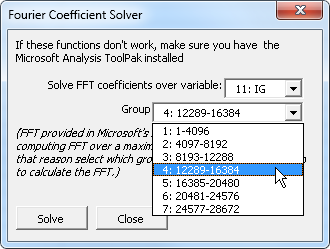
FFT data will be shown in the table:
Alternatively, FFT data can be viewed graphically by navigating to the FFT Graph tab:
The blue dots represent the calculated FFT coefficients over the first 4096 samples, the red line, the second 4096 samples and the green dots the third.
Waveform capture files from power meters, circuit breakers, reclosers and other IEDs (Intelligent Electronic Devices, in the utility vernacular) can provide valuable diagnostic information. Use this application to open a waveform file stored in the IEEE COMTRADE format and load the data found into an Excel spreadsheet. From Excel it is then a simple matter to create graphs, charts and other reports of the COMTRADE data.
I created a screencast that shows how to use it: loucks.ws/v/ct
You can download the Excel spreadsheet here: loucks.ws/v/ct/cei7b.xlsm
The VBA code is opened by clicking on Developer, then Visual Basic:

Once open, navigate through the VBA IDE to review my code.

#63
Comm Pinouts / EIA-232 (formerly known as RS-...
Last post by Dave Loucks - June 20, 2012, 08:17:43 AM25-pin EIA-232 Port
9-pin EIA-232 Port
| Pin No. | Name | Dir | Notes/Description |
| 1 | PGND | IN | Protective ground. Cable shield connected here. |
| 2 | TD | OUT | Transmit Data (a.k.a TxD, Tx). Sending data to DCE from DTE. |
| 3 | RD | IN | Receive Data (a.k.a RxD, Rx). Arriving data from DCE. |
| 4 | RTS | OUT | Request to Send. Raised by DTE when it wishes to send. Expects CTS from DCE. |
| 5 | CTS | IN | Clear to Send. Raised by DCE in response to RTS from DTE |
| 6 | DSR | IN | Data Set Ready. Raised by DCE to indicate ready. |
| 7 | SGND | - | Signal ground / common for all other signals. |
| 8 | DCD | IN | Data Carrier Detect. Raised by DCE when modem synchronized. |
| 9 | + | OUT | +VOLTAGE. Defined but typically not implemented. |
| 10 | - | OUT | -VOLTAGE. Defined but typically not implemented. |
| 11 | - | - | Unassigned pin. No connection. |
| 12 | sDCD | IN | Secondary Data Carrier Detect (or Received Line Signal Detector) |
| 13 | sCTS | IN | Secondary Clear To Send. |
| 14 | sTD | OUT | Secondary Transmit Data (sTxD). |
| 15 | TSET | IN | Transmitter Signal Element Timing. |
| 16 | sRD | IN | Secondary Received Data (sRxD). |
| 17 | RSET | IN | Receiver Signal Element Timing. |
| 18 | LL | OUT | Local Loopback. |
| 19 | sRTS | OUT | Secondary Request To Send. |
| 20 | DTR | OUT | Data Terminal Ready. Typically raised when the data terminal (PC or PLC) is powered and ready. |
| 21 | RL | OUT | Remote Loopback. |
| 22 | RI | IN | Ring Indicate. Raised by DCE and sent to DTE to tell DTE to get ready... a call is coming. |
| 23 | sCTS | - | Data Signal Rate Selector. Can sent by either DCE or DTE. |
| 24 | ETSET | OUT | External Transmit Signal Element Timing. |
| 25 | TM | IN | Test Mode. |
9-pin EIA-232 Port
| Pin No. | Name | Dir | Notes/Description |
| 1 | DCD | IN | Data Carrier Detect. Raised by DCE when modem synchronized. |
| 2 | RD | IN | Receive Data (a.k.a RxD, Rx). Arriving data from DCE. |
| 3 | TD | OUT | Transmit Data (a.k.a TxD, Tx). Sending data from DTE. |
| 4 | DTR | OUT | Data Terminal Ready. Raised by DTE when powered on. In auto-answer mode raised only when RI arrives from DCE. |
| 5 | SGND | - | Ground |
| 6 | DSR | IN | Data Set Ready. Raised by DCE to indicate ready. |
| 7 | RTS | OUT | Request To Send. Raised by DTE when it wishes to send. Expects CTS from DCE. |
| 8 | CTS | IN | Clear To Send. Raised by DCE in response to RTS from DTE. |
| 9 | RI | IN | Ring Indicator. Set when incoming ring detected - used for auto-answer application. DTE raised DTR to answer. |
#64
Modbus / Modbus VB and VBA code example...
Last post by Dave Loucks - May 23, 2012, 10:31:46 AMIf you are interested in developing a Modbus Master application, here are some programs that I wrote that you can extract code from.
Note that VB 6.0 is obsolete, but you might still have a compiler.
VB2010 Express is available as a free download (for evaluation purposes) from Microsoft. VB2013 is also available.
VB 6.0
http://pps2.com/smf/index.php/topic,12.0.html
This link takes you to a topic discussing the Encorp GPC controller and how I wrote some code to program that controller using Modbus rather than using the Lonworks protocol (which required a converter box). The VB 6.0 source code is included in that topic.
VB 2010 Express
http://pps2.com/smf/index.php/topic,4.0.html
Here's an example located elsewhere on this board of a program that I wrote to demonstrate INCOM pass-through using Modbus RTU. Embedded within this code is an example of how to write Modbus commands to read and write tables of registers. This topic also includes a link where you can download the Modbus source code I used to create a stand-alone Eaton Automatic Transfer Switch setpoint editor. Note that while this example is somewhat complex (I wrote code that embedded INCOM messages within Modbus packets which were decoded by a Modbus MINT and transmitted as INCOM messages to an ATC-600 or 800 transfer switch controller), it shows how to write VB2010 code to send and receive Modbus RTU messages via the COM serial ports.
Visual Basic for Applications - VBA (Excel 2010)
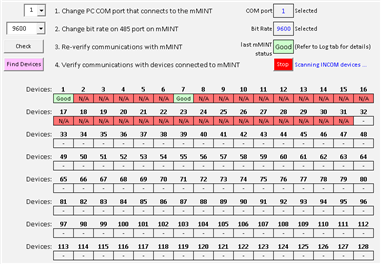
http://pps2.com/smf/index.php/topic,29.msg39.html#msg39
VB and VBA have different syntax. Neither of the VB programs above could be imported into Excel's VBA scripting language and work. So I wrote an Excel 2010 VBA Modbus program pretty much from scratch (including a new CRC-16 algorithm and a new way of interfacing with the PC hardware using Windows API calls -- didn't want to have to load any special driver -- just wanted to use "stock" Excel 2010). The application I was developing was a tool to support programming Eaton's Modbus MINT (mMINT - a simple protocol converter that translates from the legacy Westinghouse INCOM/IMPACC protocol to Modbus RTU on 485). That converter had a variety of configuration registers and people needed to resort to using something like MODSCAN to read and write them. A real pain. I wrote this to collect the data and write into Excel cells. From there it was easy to read and edit. Once done, you would press another button to write the data back to the mMINT. So if you wanted a template on how to get Excel to talk to the serial ports on your computer just open this VBA program and you'll see how I got VBA talking Modbus!
Note that VB 6.0 is obsolete, but you might still have a compiler.
VB2010 Express is available as a free download (for evaluation purposes) from Microsoft. VB2013 is also available.
VB 6.0
http://pps2.com/smf/index.php/topic,12.0.html
This link takes you to a topic discussing the Encorp GPC controller and how I wrote some code to program that controller using Modbus rather than using the Lonworks protocol (which required a converter box). The VB 6.0 source code is included in that topic.
VB 2010 Express
http://pps2.com/smf/index.php/topic,4.0.html
Here's an example located elsewhere on this board of a program that I wrote to demonstrate INCOM pass-through using Modbus RTU. Embedded within this code is an example of how to write Modbus commands to read and write tables of registers. This topic also includes a link where you can download the Modbus source code I used to create a stand-alone Eaton Automatic Transfer Switch setpoint editor. Note that while this example is somewhat complex (I wrote code that embedded INCOM messages within Modbus packets which were decoded by a Modbus MINT and transmitted as INCOM messages to an ATC-600 or 800 transfer switch controller), it shows how to write VB2010 code to send and receive Modbus RTU messages via the COM serial ports.
Visual Basic for Applications - VBA (Excel 2010)

http://pps2.com/smf/index.php/topic,29.msg39.html#msg39
VB and VBA have different syntax. Neither of the VB programs above could be imported into Excel's VBA scripting language and work. So I wrote an Excel 2010 VBA Modbus program pretty much from scratch (including a new CRC-16 algorithm and a new way of interfacing with the PC hardware using Windows API calls -- didn't want to have to load any special driver -- just wanted to use "stock" Excel 2010). The application I was developing was a tool to support programming Eaton's Modbus MINT (mMINT - a simple protocol converter that translates from the legacy Westinghouse INCOM/IMPACC protocol to Modbus RTU on 485). That converter had a variety of configuration registers and people needed to resort to using something like MODSCAN to read and write them. A real pain. I wrote this to collect the data and write into Excel cells. From there it was easy to read and edit. Once done, you would press another button to write the data back to the mMINT. So if you wanted a template on how to get Excel to talk to the serial ports on your computer just open this VBA program and you'll see how I got VBA talking Modbus!
#65
Legacy IQ Products / PowerNet software
Last post by Dave Loucks - April 20, 2012, 10:05:29 AMPowerNet Manuals and Documentation
(after clicking on this link, scroll to the bottom of the page that appears)
PowerNet was the replacement for Series III software when the release of Windows NT made it mandatory that this power monitoring software be upgraded (Series III did not run on NT). Originally conceived as a maintenance upgrade, the scope of the project required a major rewrite. Since the project scope expanded, the decision was to change the package from a running on a single PC to permitting different modules of the program to be loaded on multiple computers in a distributed client-server architecture.
These different modules included:
(after clicking on this link, scroll to the bottom of the page that appears)
PowerNet was the replacement for Series III software when the release of Windows NT made it mandatory that this power monitoring software be upgraded (Series III did not run on NT). Originally conceived as a maintenance upgrade, the scope of the project required a major rewrite. Since the project scope expanded, the decision was to change the package from a running on a single PC to permitting different modules of the program to be loaded on multiple computers in a distributed client-server architecture.
These different modules included:
- Device Server
This was the I/O scanner application. Typically one or more computers and/or Netlinks were fitted with one or more CONI cards or MINTs with each collecting field bus data (INCOM twisted pairs, one INCOM network per CONI or MINT) from dozens to thousands of devices such as meters, protective relays or I/O. The data was collected by the Device Server application and pushed onto the Ethernet network at a rate specified by the user (fast, slow, or on-demand only).
More up-to-date information on CONIs and MINTs (as well as the more modern replacements called PowerXpert Gateways or PXGs) is available on the Eaton Communication Hardware web site . - Modbus Gateway
This application typically ran in a Netlink and would permit data available on the PowerNet Ethernet backbone to be shared with a Modbus RTU master. The external Modbus master (such as a PLC, DCS or building manager system) could interrogate the PowerNet system to read data (such as voltage, current, etc.) or write data (to open or close breakers, etc.). - Configurator
Application that allowed the programmer to tell the PowerNet system which IQ devices were connected to which , provide a name, establish how fast the device should be polled, whether its data should be logged and if its data should be time stamped. - License Manager
Permitted "floating" licenses rather than connecting a license to a particular PC. - Security Manager
Created users on the PowerNet system, each with specific privledges. - Setpoints / Trip Curve
This application gave the user remote access to meter, circuit breaker and protective relay settings. If the device was configured to permit remotely changing the setpoints, this application would configure the devices. If remote changing was inhibited, this application would allow displaying the setpoints of the device(s). - Tools
This application collected data from the various device servers and stored it in a common ODBC database. This database was commonly used with E-Bill and E-Trend to creating billing data using historical data. - Waveform Viewer
Allowed displaying and uploading waveform files collected in meters, protective relays and circuit breakers. - DDE Server
Allowed a remote computer running the Windows Dynamic Data Exchange (DDE) and acting as a master to collect data from a PowerNet system as a DDE slave. - Integrator
An implementation of the Iconics GenesisTM graphics software that communicated with PowerNet using the NetPower DDE Server application. More details on the Integrator application can be found by viewing Appendix E of the PowerNet manual. - E-Bill
Allowed users to generate bills for energy consumers. Included ability to change rate schedules, rate periods, seasons and individual billing formulas. - E-Log DDE
This application allowed non-Eaton programs to collect the energy data that was stored the PowerNet system from each of the devices. - E-Trend
This program displayed trended energy data graphically.
#66
Legacy IQ Products / FRED (FAX Retrieval of Enginee...
Last post by Dave Loucks - April 20, 2012, 09:42:21 AMFAX Retrieval of Engineering Documents (FRED)
The Power Management Products Center (PMPC) developed a collection of technical documents for metering, protective relaying and power management software that were added to the original Westinghouse FRED system.
You can see a listing of those documents at http://pps2.com/communications/files/legacyPMP/litindex.htm.
The Power Management Products Center (PMPC) developed a collection of technical documents for metering, protective relaying and power management software that were added to the original Westinghouse FRED system.
You can see a listing of those documents at http://pps2.com/communications/files/legacyPMP/litindex.htm.
#67
Legacy IQ Products / Documents for old IQ meters an...
Last post by Dave Loucks - April 20, 2012, 09:38:49 AMhttp://pps2.com/communications/files/legacyPMP/prodind.htm
A CD was created back around 1999 that collected the current and legacy IQ, IMPACC and software products of the era.
The CD was created with many of the manuals, instruction booklets, software downloads and other technical information. It was created with an HTML menu system. Unfortunately, it was used and tested only on a Windows system. Windows ignores case in URL addresses, so many of the file names and the link names used mixed case. This worked fine under Windows however when this content was uploaded to this server, the menu system no longer worked.
This is because this message board is hosted on a system running Linux, and like UNIX, Linux cares about the case in URLs.
To get the system up and running as soon as possible, we ran a couple of scripts to rename the files and all the text in the files referencing these links to lowercase. A byproduct of that renaming script is that the text in the menus is now all lowercase. The content referenced by those links is unaffected.
Most of the links should now work (if they don't it is because we missed it... just rename the path to have all lowercase characters after the "legacyPMP/".
A CD was created back around 1999 that collected the current and legacy IQ, IMPACC and software products of the era.
The CD was created with many of the manuals, instruction booklets, software downloads and other technical information. It was created with an HTML menu system. Unfortunately, it was used and tested only on a Windows system. Windows ignores case in URL addresses, so many of the file names and the link names used mixed case. This worked fine under Windows however when this content was uploaded to this server, the menu system no longer worked.
This is because this message board is hosted on a system running Linux, and like UNIX, Linux cares about the case in URLs.
To get the system up and running as soon as possible, we ran a couple of scripts to rename the files and all the text in the files referencing these links to lowercase. A byproduct of that renaming script is that the text in the menus is now all lowercase. The content referenced by those links is unaffected.
Most of the links should now work (if they don't it is because we missed it... just rename the path to have all lowercase characters after the "legacyPMP/".
#68
Networking Hardware / SmartWire-DT
Last post by Dave Loucks - April 11, 2012, 09:03:01 AMLearn more about this technology:
http://www.eaton.com/Electrical/USA/ProductsandServices/AutomationandControl/Connectivity/index.htm
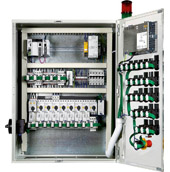
http://www.eaton.com/Electrical/USA/ProductsandServices/AutomationandControl/Connectivity/index.htm

#69
Networking Hardware / Power Xpert Architecture
Last post by Dave Loucks - April 11, 2012, 08:58:01 AMDiscusses current models of gateways, gateway cards, Ethernet switches, INCOM interfaces (IPONI, MPONI, DPONI, MINTII, mMINT and PMINT):
http://www.eaton.com/Electrical/USA/ProductsandServices/PowerQualityandMonitoring/NetworkingHardware/index.htm
http://www.eaton.com/Electrical/USA/ProductsandServices/PowerQualityandMonitoring/NetworkingHardware/index.htm
#70
INCOM / IMPACC / NRX Communications Adapter
Last post by Dave Loucks - April 11, 2012, 08:51:58 AMInstallation instructions for Series NRX INCOM Communications Adapter Module (ICAM):
http://www.eaton.com/ecm/groups/public/@pub/@electrical/documents/content/il01301033e.pdf
http://www.eaton.com/ecm/groups/public/@pub/@electrical/documents/content/il01301033e.pdf
